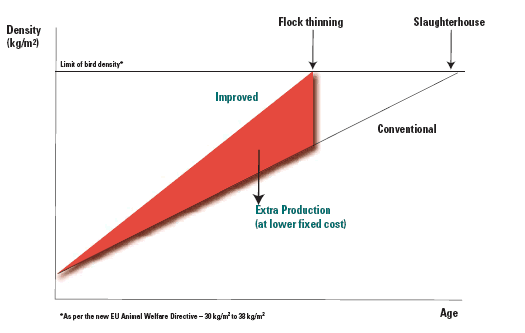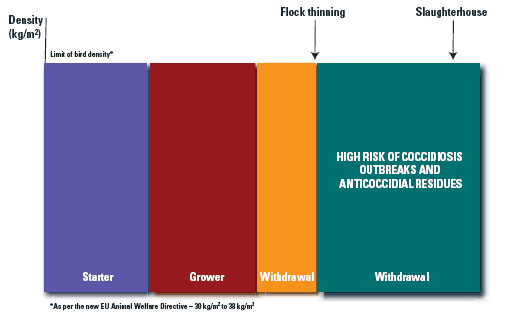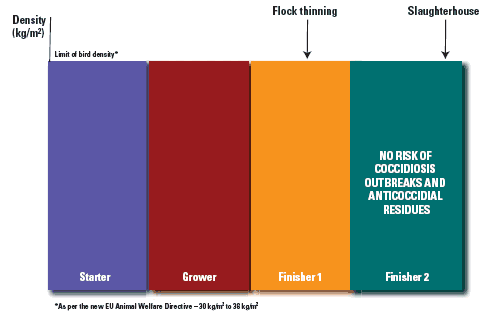Thinning Flocks to Fatten Profits
Vaccination for coccidiosis complements thinning, increases flexibility for producers.
It's easy to see why thinning broiler flocks has become a popular practice throughout Europe. Thinning lets poultry farmers satisfy market demand for light or heavier birds and, at the same time, capitalize on the economies of scale and enjoy increased profits.But when traditional in-feed drugs are used to control coccidiosis, thinning has a down side. The required withdrawal times for anticoccidials hinder market flexibility and complicate feed management. With anticoccidials, there is always concern that residues of the drugs could end up in poultry meat at a time when public demand for food safety is at an all-time high.
Farmers can, however, optimize the benefits of thinning and eliminate the problems inherent to anticoccidial use by vaccinating against coccidiosis at day-of-age.
"Vaccination fine tunes the practice of thinning," says Dr. Paolo Sani, a veterinarian and poultry business manager for Schering-Plough Animal Health in Italy.
"It not only provides lifelong protection against coccidiosis, it increases market flexibility, dramatically simplifies feed management and completely eliminates worries about anticoccidial residues.
"In fact, we are finding that coccidiosis vaccination has evolved from a disease-control method into a management tool that enhances the practice of thinning," he says.
How thinning works
When flocks are thinned, Sani explains, lighter, less efficient females are sold. The weight at which females are thinned out varies among companies and with market needs. Some companies may start female thinning at about days 35 to 37 (Figure 1), when the birds are 1.7 kg (3.75 lbs). Occasionally, there is a thinning of heavy females or light males about days 44 to 46, when birds are 2.4 to 2.6 kg (5.29 to 5.73 lbs). After each thinning, space is freed up for a greater number of faster-growing, large-breasted males that are sold later in the production cycle for chicken parts and high-volume commercial sales, Sani says. Figure 1. Flock-thinning concept, typical scheme |
Thinning can be practiced within the limits of European Union welfare laws, which dictate a maximum of 30 kg (66.14 lbs) meat production per square meter in buildings with natural ventilation systems and 38 kg (83.78 lbs) of meat produced per square meter in buildings with artificial ventilation systems, he notes.
Generally, the same house is used for all birds in flocks to be thinned, but males and females are divided by removable fences. After the first thinning, the remaining birds occupy the full space, he says. Additional thinnings can be made based on market demand, in contrast to "mono" systems that start all birds at the same time and send them to market at the same time. Thinning provides farmers with the best balance of light and heavy birds. It significantly improves space utilization and the kilos of meat produced per square meter, reduces fixed costs and improves performance among heavy birds, Sani says. "Farmers have increased income and better return per kg of meat, while the integrator optimizes the logistics of broiler production," he notes.
Cost savings
 Figure 2. Flock thinning, feed management with in-feed anticoccidials |
For instance, since thinning enables more birds to be raised in the same house, the costs for transporting feed and chicks to the house as well as chicks to market declines, he says.
Economic analysis demonstrates that transport of feed alone, determined by examining the results among several producers in Italy, can be reduced from 10% to 20% by thinning, although the savings would vary by country and among different producers. The estimated cost reductions among several Italian producers for transporting chicks to farms and to the slaughterhouse ranged from 20% to 30%, Sani says.
Dr. Luciano Gobbi, technical service manager for Schering-Plough Animal Health, Italy, says there's another added benefit from thinning. "It becomes easier to raise heavier birds in the heat of summer."
As the chicks age, heat can be detrimental to their health, but thinning gives heavier birds more space and they can remain cooler, he says. Thinning, however, definitely complicates coccidiosis control when traditional in-feed anticoccidials are used, Dr. Gobbi agrees.
" A n t i c o c c i d i a l s require at least a 5-day withdrawal time (see Figure 2), so birds marketed early have to receive a withdrawal feed before they are sent to slaughter. Great care must be taken to assure that the right birds within a flock get the correct feed," he says.
When anticoccidials are removed to adhere with withdrawal requirements, birds intended for early marketing are at risk for a costly coccidiosis outbreak, he says.
"The overriding concern about the use of in-feed anticoccidials, however, is that residues of the drugs will unintentionally end up in poultry meat, which could be immensely damaging to a poultry producer in light of the public focus on food safety. All it takes is an error at the feed mill or a farmhand giving the wrong feed to the wrong group of birds within a flock," Gobbi says.
All the potential complications associated with anticoccidial use can be eliminated simply by vaccinating birds against coccidiosis once at 1 day of age, Gobbi says. In return, farmers who thin their flocks will find that management of feed and of the birds will be dramatically simplified, he says.
Case in point
 Figure 3. Flock thinning, feed management with Paracox-5 |
As a case in point, Gobbi points to Martini Alimentare, one of Italy's major poultry companies, which has coupled Paracox-5 vaccination against coccidiosis with the practice of thinning (CocciForum, No. 10). Males and females are kept in the same house but in separate areas. Females are usually thinned out at days 35 and 42, some males are thinned out at 46 days and the remaining males are slaughtered at 54 to 56 days.
Dr. Corrado Longoni, poultry veterinarian for Martini, says, "If we used an anticoccidial in the feed, it would mean having two or three withdrawal periods, which would be very difficult to manage."
Feed mill contamination would also be a very real concern for Longoni if the company used in-feed anticoccidials. The feed mill does not make feed just for broilers, he says, and the lines at the mill would have to be flushed after every use to insure that anticoccidial residues did not get into feed for non-target species.
"We can't take that risk, nor do we want traces of drugs in our withdrawal feed for broilers," Longoni says.
"Martini as well as other companies that practice thinning," says Gobbi, "are discovering that vaccination is a real problem solver and that it provides excellent control against coccidiosis. When coupled with good nutrition, the performance among vaccinated birds at the very least meets performance among birds raised with in-feed anticoccidials."
Vaccination also yields indirect savings for poultry farmers by reducing the labor it takes to manage the feed and the birds in thinned flocks. "It's an excellent complement to the practice of thinning," he says.
Source: CocciForum Issue No.12, Schering-Plough Animal Health.







